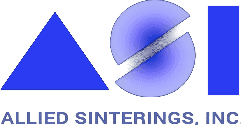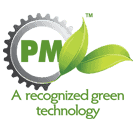Metal sintering is a manufacturing process that involves heating powdered metal particles until they bind together. This technology is used to precisely produce complex metal pieces. During sintering, the powder is heated below its melting point, allowing it to bond and form a robust component. It is a widely employed method because it is environmentally friendly, low cost, and can create durable components.
Allied Sinterings has been expertly crafting powdered and sintered metal goods since 1959! Our team utilizes top-notch powders and materials, and clients in diverse sectors regard our proficiency in handling complex shapes. Moreover, our Danbury plant has three sintering furnaces and 42 high-precision Dorst compacting presses from Germany. We also have a complete in-house tool room and tumbling and finishing department.
The Sintering Process in Powder Metallurgy
Here is a detailed breakdown of the sintering process:
Step 1: Blending
The initial step involves mixing powdered metals to form a homogenous blend. The mixture consists of iron as the base and alloying elements and additives to achieve the desired specific properties. These additional materials can enhance strength, durability, corrosion resistance, and electrical conductivity.
Step 2: Compacting
Once the powdered metal blend is prepared, it is carefully loaded into the compacting equipment. This equipment has carbide and steel tools, which exert significant pressure (ranging from 400 MPa to 800 MPa) on the mixture. This intense force causes the powder particles to bond together, forming what is known as a ‘green’ part.
Step 3: Sintering
The ‘green part’ is gradually heated to a temperature in a controlled atmosphere that remains below the melting point of the primary powdered metals. This controlled heating process facilitates diffusion, where powder grains bond and grow together. It results in a significant increase in the strength and density of the part. The controlled atmosphere during sintering is crucial to prevent oxidation or contamination of the metal.
Step 4: Cooling
The furnace typically comprises three distinct zones: pre-heating, sintering, and cooling. The sintered part is carefully cooled to room temperature while maintaining a controlled atmosphere in the last zone. This prevents air ingress and oxidation, ensuring that the final part’s properties are preserved. Carefully managing these zones can help achieve the desired mechanical and material characteristics.
Step 5: Post-Processing (Secondary Operations)
Secondary operations are often necessary after sintering to refine metal components’ structural and dimensional attributes. These may involve coining and resizing, steam and heat treatment, vacuum or oil impregnation, structural infiltration, or resin or plastic impregnation. Machining and grinding processes are also employed for precise shaping and surface modifications. Additionally, the parts can have a plating or finish applied in a variety of materials, including the following:
- Nickel
- Zinc-Chromates
- Teflon
- Chrome
- Copper
- Gold
- And numerous others
Benefits of the Sintering Process
The following are the key advantages of sintering:
Complex Shapes
One of the significant advantages of metal sintering is its ability to produce components with complex shapes. It stems from the powder-based nature of the process, which allows for intricate geometries that would be challenging to achieve through traditional methods. This versatility is advantageous in various industries and applications, including aerospace and automotive engineering.
High Dimensional Precision
Metal sintering is known for its exceptional dimensional precision, ensuring that the final product closely adheres to customer-defined tight tolerances. This control level is accurate and consistent, which makes it particularly beneficial for high-volume production runs. Moreover, it reduces the need for post-processing or rework.
Reliability and Repeatability
The process can consistently deliver parts that conform to tight specifications and ensures that each unit meets quality control criteria. This reliability extends to the predictability of outcomes, enabling efficient planning and resource allocation. Manufacturers can confidently scale up production, knowing that the sintering technique will yield the desired results consistently.
Self-Lubrication Capabilities
Components with self-lubricating properties require less frequent manual lubrication and maintenance. This translates into cost savings and increased operational efficiency, particularly in industries where equipment uptime is crucial. Furthermore, reduced friction from sintered components can enhance overall system performance.
Green Technology
Unlike traditional manufacturing processes, metal sintering does not produce harmful emissions like volatile organic compounds (VOCs) or greenhouse gases. This reduces the environmental footprint of the production. The technique can also be highly energy-efficient, especially with modern technologies and equipment.
Improved Physical Properties
During sintering, the high-temperature environment reduces the amount of oxygen present on the surface of the powdered metal particles. This reduction helps to mitigate the risk of oxidation, which can weaken the workpiece. It also promotes the formation of sintered necks between adjacent particles. These necks act as strong bonds, enhancing the structural integrity and strength of the material.
Applications of Sintered Metal Products
Below are the different industries leveraging metal sintering and their respective products, parts, and components:
- Automotive and electric vehicle (EV): engine components, transmission parts, brake systems, electric motor frameworks, actuators, heat exchangers, and battery components
- Aerospace: aircraft engine components, landing gear parts, turbine blades, bearings, fuel systems, and actuators
- Medical: surgical instruments, orthopedic implants, dental tools, prosthetic devices, diagnostic tool components, and drug delivery systems
- Robotics and automation: robot joints and gears, precision actuators, conveyor system parts, grippers and end effectors, tool changers, and custom robotic parts
- Industrial machinery: bearings and bushings, pump and valve parts, compressor components, and coupling and connectors
- Defense: firearms parts, armor and protective gear, ammunition components, aircraft and vehicle parts, and surveillance and optics
- Consumer goods: cutlery and kitchenware, lock and door hardware, watch components, fashion accessories, power tool parts, firearms, and commercial appliances
Sintered Metal Products at Allied Sinterings
Here is an overview of Allied Sinterings’ sintered metal product offerings:
Fine Pitch Gears
Allied Sinterings provides precise and miniature fine-pitch gears tailored for small-scale mechanisms. These components guarantee top-notch performance and reliability as they are customized to suit the unique demands of each client. They also find applications in diverse fields, such as medical devices, robotics, and automotive components.
Structural Components
We employ a powdered metal compaction process to craft compact structural components on a small scale. This method excels in the production of high-volume parts that demand strict tolerances. The features also match the precision of machined counterparts but offer quicker production turnaround, reduced waste, and cost-effectiveness.
Planetary Gear Drives
We produce planetary gear drives using various materials, including stainless steel, nickel, copper, and brass alloys. These components serve multiple sectors, such as tractors, powered medical devices, shade systems, cordless home improvement tools, automotive applications, and construction equipment. We also offer diverse choices for enhancing the gear tooth surfaces — machining, resin or oil impregnation, heat treating, and tumbling.
Choose Allied Sinterings for High-Quality Sintered Metal Products
Allied Sinterings has been at the forefront of manufacturing powdered and sintered metal products for over six decades! Our team has an unwavering commitment to delivering top-quality components that meet the most stringent requirements. Moreover, we consistently uphold the highest standards in material excellence.
Contact us today to learn more about our capabilities or request a quote to get started with us!



